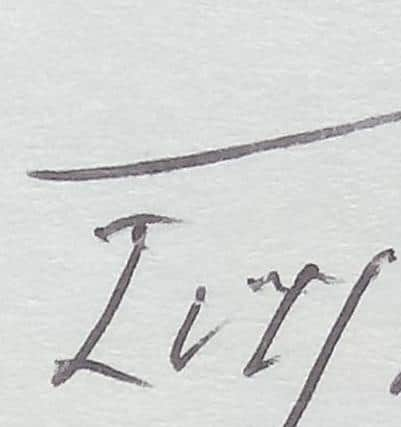Warm summertimes past in the flax fields of a local family farm


So much so that I phoned sender Ivy Lambert, whose house in Ballygawley is called ‘Westering Home’.
Ivy recited the verse from whence the name:
“Westering home with a song in the air,


Light in the eye and it’s goodbye to care.
Laughter and love are a welcoming there,
Isle o’ my heart, my own love.”
I’ll share Ivy’s wonderfully descriptive letter in a moment - about flax growing and harvesting on her family farm in County Tyrone - but first, a short introduction.
Advertisement
Hide AdAdvertisement
Hide AdShe’s 88 years old (though sounding like a teenager!) living in Westering Home “high up, overlooking the lake”.
Her late husband, civil engineer Brian Lambert, designed Ballygawley roundabout, the major landmark and central hub for the roads from Belfast to Omagh/Strabane/north Donegal, Enniskillen/Sligo/south Donegal, and Londonderry to Monaghan/Dublin.
Ivy’s letter is her personal story of Irish flax told in a way that warms the heart in these difficult times.
The beautiful, blue-flowered crop was an absolutely vital part of our history yet the last time it was mentioned here was last November, in Dublin author Ann Lane’s book about Ireland’s outdoor sculptures entitled ‘By the Way 2’.
Advertisement
Hide AdAdvertisement
Hide AdAnn highlighted Alan Burke’s stunning flax flower installation in the mill pond in Bessbrook.
The rest of today’s page is Ivy Lambert’s equally stunning letter about flax farming.
Dear Roamer,
Perhaps my epistle may be some use as not many would know of flax growing. Excuse my writing as I had a bad stroke two years ago and had to learn how to write again but with physio etc I am now living independently again.
Just recently someone said to me that farming nowadays is a highly specialised science and aspiring farmers need a very comprehensive training.
Advertisement
Hide AdAdvertisement
Hide AdI agree that they do, and driving some of the machinery monsters that we now see need the driver to be both skilled and alert.
As a woman of 88 years old I got to thinking about life on a fairly ordinary farm where I was brought up.
I was thinking especially of the war years when farmers were encouraged to grow flax for the war effort. Not every farmer took up the challenge but my father did and we children loved it as it was something new.
Of course, he knew nothing about growing flax and had to learn from the beginning.
Advertisement
Hide AdAdvertisement
Hide AdI don’t know how many farmers in the Douglas Bridge area where we lived grew flax, but there must have been quite a few as we were near Sion Mills where the linen was processed.
First, the ground was prepared as for a grain crop and the flax seed was sown by a corn fiddle.
By summer our two fields were a sight to behold - a sea of bright blue flowers shining in the sunlight.
Summers then seemed to be all sunshine and my father said he hung up his winter coat in March and didn’t see it again till October!
Advertisement
Hide AdAdvertisement
Hide AdThe flax was then pulled and put into ‘beets’ rather like sheaves of corn. These then went to flax dams filled with water and were submerged for some weeks till they were absolutely stinking. This was called ‘retting’.
Not many of these dams are left - all filled in - but my nephew David Hill built his new house near Omagh where there had been a dam.
He calls it Flax Dam Cottage which I think recalls the past beautifully and is a nod to his grandfather who also had a flax dam.
The beets were then taken out of the dam and spread in lines on the fields.
Advertisement
Hide AdAdvertisement
Hide AdBy this time my father had got a new grey Ford Ferguson tractor and although I was only 14 or 15 years old I remember driving it and putting out the smelly cargo which then dried till it was almost white.
When it was dry in those long, hot summers, it was lifted with rounded tools resembling bill hooks, though not sharp, and put into beets again.
It ended up in ‘sheigs’ like corn stacks.
Two rows of beets were set upright leaning against each other and more were added to make a square stack.
My job was to crawl through the centre to make sure there was an air hole up the middle.
Advertisement
Hide AdAdvertisement
Hide AdThe flax then went to the scutch mill where the linen fibre was separated from its casing called ‘shows’.
My spelling of all these words may be wrong as I have never seen them in print.
Many poor families burnt these ‘shows’ for a cheap means of heat.
Recent events have made me think of the war years.
David Attenborough is always telling us about climate change but back then summers seemed to be weeks of prolonged sunshine when my brother and I seemed to lead a charmed existence in the heat of the summer days.
Advertisement
Hide AdAdvertisement
Hide AdI guess there are few around now who remember how flax was grown.
It was all done by farmers who had never trod the hallowed steps of Greenmount Agricultural College.
No doubt they had agricultural advisers but they still deserve credit for their enterprise and willingness to learn something new.